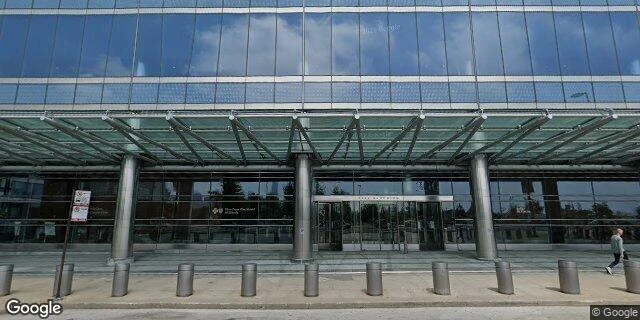
Attribution: © Google 2025
Building Info
- Square Footage
- 2,286,697 sqft18x median124,364 sqft10x median Office231,240 sqft
- Built
- 2010
- Primary Property Type
- Office
- Community Area
- Loop
- Ward
- 42
-
Chicago Energy Rating
- 3.5 / 4
-
Energy Star Score
- 53 / 100
- Owner
2020 Report Card
Debug Full Grade Data
- AvgPercentileLetterGrade: C
- AvgPercentileGrade: 53.9750316962344
- GHGIntensityLetterGrade: F
- GHGIntensityPercentileGrade: 12.707182320441987
- EnergyMixLetterGrade: A
- EnergyMixWeightedPctSum: 99.6060770327839
- EnergyMixPercentileGrade: 94.0536013400335
- SubmittedRecordsLetterGrade: A
- MissingRecordsCount: 0.0
- SubmittedRecordsPercentileGrade: 100.0
Emissions & Energy Information for 2020
- Greenhouse Gas Intensity F
- 11.1 kg CO2e / sqft1.8x median6.2 kg CO2e / sqft1.7x median Office6.6 kg CO2e / sqft
- Total Greenhouse Gas Emissions
- 24,654 tons CO2e29x median841.4 tons CO2e15x median Office1,647.9 tons CO2e
Years Reported
6/10
A

2014
2015
2016
2017
2018
2019
2020
2021
2022
2023
Energy Breakdown for 300 E Randolph
- Fossil Gas Use (aka Natural Gas)
- 728,377 kBtuEst. Gas Bill: $9,000 for 2020**1/8 median5,517,828 kBtu1/7 median Office4,958,713.7 kBtu
- Electricity Use
- 144,238,480 kBtuEst. Electric Bill: $6,045,000 for 2020**40x median3,580,332.6 kBtu16x median Office9,303,318.1 kBtu
- District Chilled Water Use
- 39,936,577 kBtu5x median7,765,434.2 kBtu
Energy Mix A
Total Energy Use: 184,903,436 kBTU
Scan To Learn More
https://electrifychicago.net/building/300-e-randolph/
View Extra Technical & Historic Info
- Source Energy Usage Intensity
- Not Reported
This data was not reported for this building this year, which likely means a value of zero for this field.
- Site Energy Usage Intensity
- Not Reported
This data was not reported for this building this year, which likely means a value of zero for this field.
Full Historical Data Table for 300 E Randolph
| Year |
Overall Grade |
Emissions Intensity Sub-Grade |
Energy Mix Sub-Grade |
Reporting Mix Sub-Grade | GHG Intensity kg CO2e / sqft | GHG Emissions metric tons CO2e | Energy Mix | Electricity Use kBTU | Fossil Gas Use kBTU |
District Chilled Water Use kBTU | Source EUI kBTU / sqft | Floor Area sqft |
Chicago Energy Rating |
Energy Star Score |
|---|---|---|---|---|---|---|---|---|---|---|---|---|---|---|
| 2014 | B | C | B | A | 12.81 | 28,430 | 66%Electricity 1%Fossil Gas 32%Other | 124,794,002 | 2,559,937 | 61,058,975 | 205 | 2,218,838 | - | 77.0 |
| 2015 | B | D | A | A | 12.2 | 27,139 | 63%Electricity 1%Fossil Gas 35%Other | 117,146,687 | 2,471,188 | 65,819,386 | 196.6 | 2,218,838 | - | 78.0 |
| 2016 | C | D | A | A | 11 | 24,303 | 62%Electricity 1%Fossil Gas 37%Other | 112,059,224 | 2,350,987 | 66,778,322 | 189.8 | 2,218,838 | - | 80.0 |
| 2017 | C | F | A | A | 17 | 37,931 | 74%Electricity 1%Fossil Gas 25%Other | 186,219,761 | 2,619,642 | 63,713,158 | 292.7 | 2,224,842 | - | 43.0 |
| 2018 | C | F | A | A | 15.3 | 34,122 | 76%Electricity 1%Fossil Gas 23%Other | 186,738,009 | 2,391,879 | 55,559,401 | 258.9 | 2,224,842 | 1.5 | 30.0 |
| 2019 | - | 174,764,755 | 2,530,520 | - | 2,224,842 | 2.0 | 43.0 | |||||||
| 2020 | C | F | A | A | 11.1 | 24,654 | 78%Electricity 0%Fossil Gas 22%Other | 144,238,481 | 728,377 | 39,936,578 | 198.2 | 2,286,697 | 3.5 | 53.0 |
| 2021 | - | 90,313,081 | 846,900 | 50,606,271 | 134.8 | 2,286,697 | 2.0 | - | ||||||
| 2022 | - | 100,579,667 | 1,172,100 | 42,724,651 | 144.6 | 2,286,697 | 4.0 | 69.0 | ||||||
| 2023 | - | 91,736,568 | 1,464,100 | 29,808,189 | 128.3 | 2,224,842 | 3.5 | 75.0 |
* Note on Rankings: Rankings and medians are among included buildings, which are those who reported under the Chicago Energy Benchmarking Ordinance for the year 2023, which only applies to buildings over 50,000 square feet.
** Note on Bill Estimates:
Estimates for gas and electric bills are based on average electric and
gas retail prices for Chicago in 2021 and
are rounded. We expect large buildings would negotiate lower rates with
utilities, but these estimates serve as an upper bound of cost and help
understand the volume of energy a building is used by comparing it to
your own energy bills! See our
Chicago Gas & Electric Costs Source
for the original statistics.
Data Source:
Chicago Energy Benchmarking Data